

Explore Cornell - Home Gardening - Vegetable Growing Guides - Growing Guide. Www.samgro.co.za/Tree selection guide.pdf. Planting Fruit Trees. Search for other topics in Food-Skills-for-Self-Sufficiency.com: There are proper methods for planting fruit trees (and any other tree for that matter) to assure a quicker start healthier tree and earlier crops.
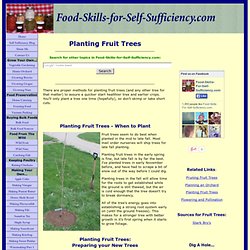
South Africa - Summer rainfall climate kitchen garden - Garden calendar and reminders. Home | Vegetables and herbs to plant | Climate zones | About Gardenate | Contact us This planting guide is a general reference intended for home gardeners.
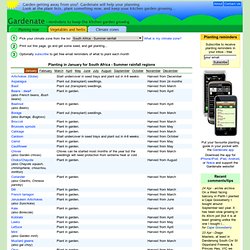
We recommend that you take into account your local conditions in making planting decisions.
Spring Seed. Square Foot Gardening in South Africa. Do The Chop n' Drop. The Guerrilla Gardening Home Page. Vegetable Resources. 5 Foods You Can Grow From Leftovers. Looking for yet another way to get more from your garden?

How about regrowing vegetables from the leftover bits and pieces? Reduce, reuse and recycle in your garden with these five foods that you can keep growing (and regrowing) even after you've gotten a good meal or two out of them. Did you know that you can regrow celery from the leftover stalk stub? It's true. Just take a freshly cut bottom (the whole stub), soak it in warm water overnight, then plant it (cut side up) in fertile soil. Growing Food from Kitchen Scraps. There's all sorts of growing experiments you can do with your kids just by using food from your kitchen.
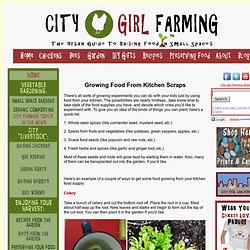
The possibilities are nearly limitless...take some time to take stalk of the food supplies you have, and decide which ones you'd like to experiment with. To give you an idea of the kinds of things you can plant, here's a quick list: 1. Whole seed spices (like corriander seed, mustard seed, etc.) 2. 3. 4. Most of these seeds and roots will grow best by starting them in water. Here's an example of a couple of ways to get some food growing from your kitchen food supply: Celery Take a bunch of celery and cut the bottom root off. Potato Keep a potato around until some eyes start growing on it. Www.uicnmed.org/nabp/web/documents/Essential oils study - UK.pdf. Growing Shiitake Mushrooms is Easier Than You Think. Written by Mindy on January 17th, 2013.

HOW TO: Grow an Avocado Tree from Seed. Avocados are one of the wonderful fruits of summer.
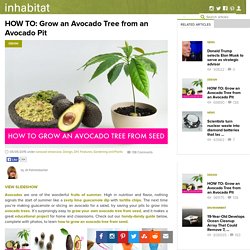
High in nutrition and flavor, nothing signals the start of summer like a zesty lime guacamole dip with tortilla chips. The next time you’re making guacamole or slicing an avocado for a salad, try saving your pits to grow into avocado trees. It’s surprisingly easy to grow your own avocado tree from seed, and it makes a great educational project for home and classrooms. How to Grow A Potato Vine Plant. If you want to grow a sweet potato vine plant, all you need to do is to follow the next steps.
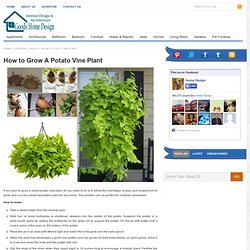
Is easy and inexpensive to grow, and is a very sweet decorative plant for any home. This solution can pe perfect for a kitchen windowsill. How to make: Tomato Problem Solver. Hortishop. Easy Organic Compost. Compost is the best way to improve your soilIf you use compost you probably won’t need to use fertilizerCompost doesn’t harm beneficial organisms like earthworms (chemicals do)If you have a yard, you are already doing most of the work to make compostCompost is free, easy, and saves energyYou can start a compost pile any time you have material for it This compost pile is already 155 degrees F after only 3 days! A hot pile like this does a good job of killing weed seeds and disease organisms.
How to do it Use your lawn mower to chop up leaves, and then go over them again and use the grass catcher to collect the chopped leaves. If you don’t want to chop up your leaves you certainly don’t have to, but you won’t have to empty the grass catcher nearly as often if you do, and your compost will have a much finer texture.Use your lawn mower/grass catcher to collect grass clippings.Combine 3 parts leaves with 1 part grass clippings in layers to build your compost pile. Potatoes in a Woodrow Style Mandala Bed Permaculture Research Institute. A technique for mounding potatoes in a mandala bed without importing soil, with the benefit of improving fertility and increasing organic matter. by Grahame Eddy I like to mound my potatoes by pushing soil up against the sides of the growing plants eventually creating quite a big mound.
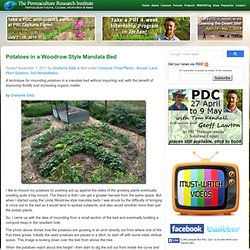
The theory is that I can get a greater harvest from the same space. But when I started using the Linda Woodrow style mandala beds I was struck by the difficulty of bringing in more soil to the bed as it would tend to spread outwards, and also would smother more than just the potato plants. So, I came up with the idea of mounding from a small section of the bed and eventually building a compost heap in the resultant hole. The photo above shows how the potatoes are growing in an arch directly out from where one of the fruit trees grows. How to Grow Garlic: Organic Gardening. Soil preparation: Garlic will tolerate some shade but prefers full sun.
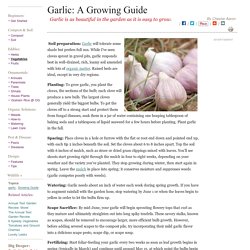
While I've seen cloves sprout in gravel pits, garlic responds best in well-drained, rich, loamy soil amended with lots of organic matter. Raised beds are ideal, except in very dry regions. Growing Your Own Garlic - Planting Growing Harvesting and Storing Garlic ... - StumbleUpon. As far as I'm concerned, garlic gets the blue ribbon for growing your own.

It's absurdly easy to plant and care for; it tastes great; it looks beautiful and it takes up so little ground that even those with very small gardens can raise enough to be self-sufficient in garlic for a good part of the year. All you have to do is choose the right varieties; plant at the right time, in the right soil; then harvest when just right and store correctly. 1. Choosing Types of Garlic If you look in a specialist catalog like the one at Gourmet Garlic Gardens, you'll find dozens of varieties of garlic listed. You see where this is going – and you can see a lot more types of garlic on either of those websites, but for general purposes the most important difference is the one between softneck and hardneck.
Softnecks are so called because the whole green plant dies down to pliancy, leaving nothing but the bulb and flexible stems that are easy to braid. Gardeners in most of the U.S. can try some of both. 2. 35 Pest and Disease Remedies. Before you begin... My friend and garden assistant, Peggy, tells me that of all the yards she helps tend, mine is the healthiest (although it is not necessarily the tidiest).
I credit that health to myriad factors. Every speck of my growing areas (even potted plants) is covered with rich organic matter like aged compost, worm castings, or shredded leaves. How to: create a Planting Calendar, Allsun style. I must say that while I’m finding this market garden experiment very exciting, it’s also rather daunting. What are we planting today? What are we planting next week? Where are we going? Who am i and where are my pants? Cera Trap: The most effective and ecological solution for controlling Med fruit fly.
5 Secrets to a ‘No-work’ Garden. It took over 20 years of gardening to realize that I didn’t have to work so hard to achieve a fruitful harvest. As the limitless energy of my youth gradually gave way to the physical realities of mid-life, the slow accretion of experience eventually led to an awareness that less work can result in greater crop yields. Inspired in part by Masanobu Fukuoka’s book, One Straw Revolution, my family experimented with gardening methods which could increase yields with less effort. Fukuoka spent over three decades perfecting his so-called “do-nothing” technique: commonsense, sustainable practices that all but eliminate the use of pesticides, fertilizer, tillage, and perhaps most significantly, wasteful effort.
Here are the strategies we used which enabled us to greatly increase our garden yield, while requiring less time and less work. 1. DIY Greenwalls. 12 Vertical Garden Tutorials. There's a saying in the construction biz. It goes something like this: If you can't build out, build up. It's also the fuel that started the vertical gardening craze. But for those of us with the space to put in horizontal gardens, the vertical still beacon. How to Turn a Pallet into a Garden. Good news and bad news. Living Walls - Vertical Gardens - Living Roofs - Vertical Landscapes - South Africa. Mandala Garden.